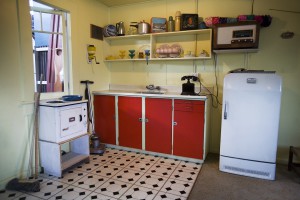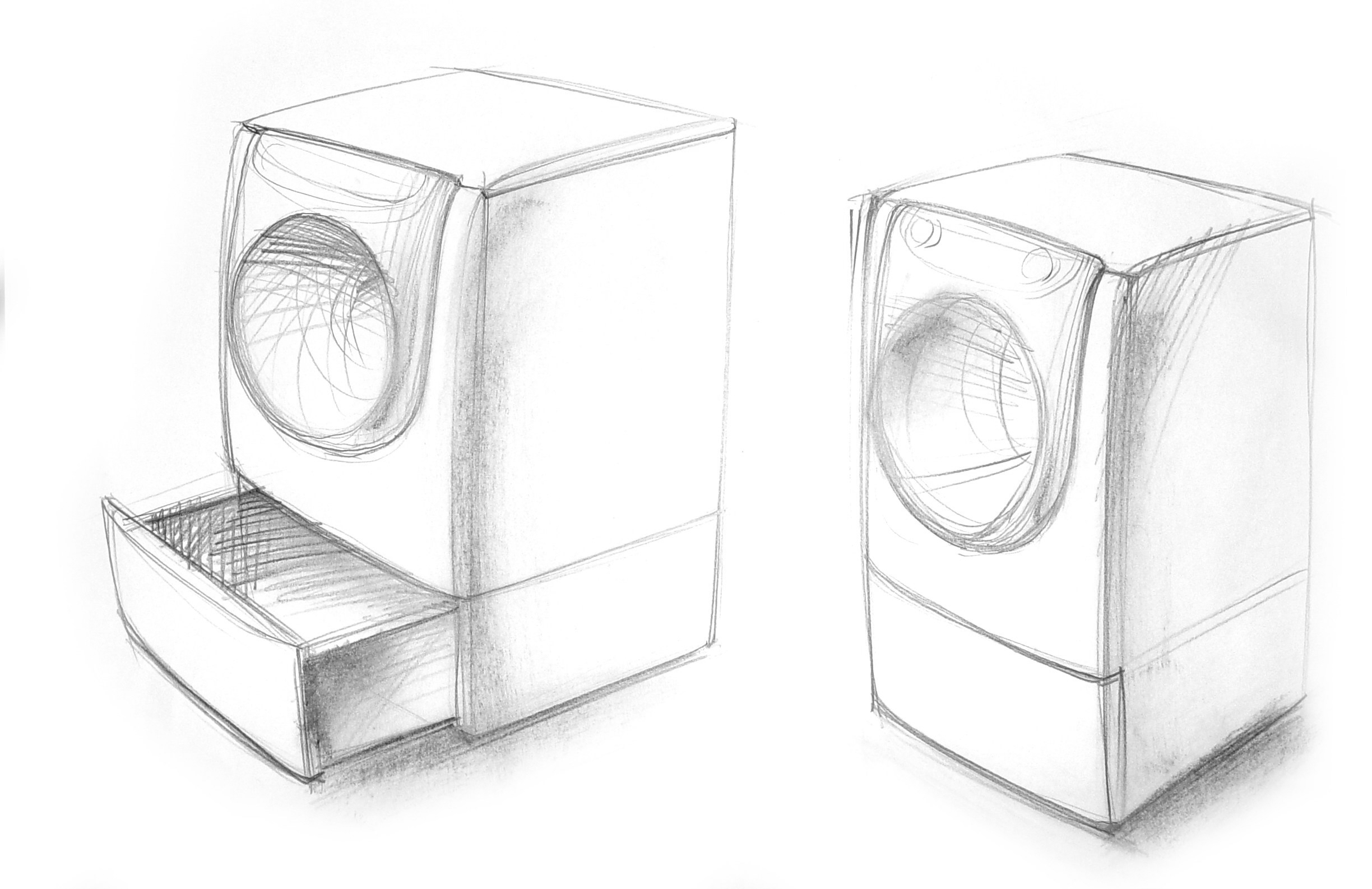How do the appliances have changed from the Fifties to today? From bulky and unappealing products, they have slowly evolved, becoming more and more technological and aesthetic.
 The Fifties marked the beginning of the aesthetics evolution, although many modern appliances that we use today were created between late Nineteenth century and early Twentieth century, thanks to the discovery of the electricity. In the past, the appliances often were bulky and without any attention to the aesthetics: their function was the only important aspect. Despite they were born with the intent to become mass products, the appliances such as refrigerators, vacuum cleaners and washing machines were a status symbol of rich families for decades, being very expensive. We have to wait until the Fifties – years of the economic boom that followed the end of the world wars – to assist at the first diffusion of the home appliances. The diffusion have been also facilitated by the improvements in technology, the lower prices and the greater functionality. And it is from this moment that manufactures and people begin to pay attention to the outward appearance of the devices.
The Fifties marked the beginning of the aesthetics evolution, although many modern appliances that we use today were created between late Nineteenth century and early Twentieth century, thanks to the discovery of the electricity. In the past, the appliances often were bulky and without any attention to the aesthetics: their function was the only important aspect. Despite they were born with the intent to become mass products, the appliances such as refrigerators, vacuum cleaners and washing machines were a status symbol of rich families for decades, being very expensive. We have to wait until the Fifties – years of the economic boom that followed the end of the world wars – to assist at the first diffusion of the home appliances. The diffusion have been also facilitated by the improvements in technology, the lower prices and the greater functionality. And it is from this moment that manufactures and people begin to pay attention to the outward appearance of the devices.
Fifties: the attention to aesthetics is born
In the Fifties, the appliances start to get noticed in the kitchen, especially the refrigerator with rounded lines and corners and door with horizontal metallic handle. Often the devices weren’t realized in white colour, but in soft tones like the cream colour of the gas cookers, very common in the Italian homes. The kitchens had circular hobs, on which to place directly pots and pans, and a oven without glass. The washing machine was generally like a big basin where the laundry was loaded from the top. In the Fifties, the first collaborations with designers begin: in particular, Gino Valle, who worked for the Zanussi design center, and Pietro Geranzani, who signed many Candy washing machines; both brought a useful design in the appliances, created to facilitate the use of the devices. On January 3rd 1954, RAI (Italian television) officially began to broadcast and the television began to appear in Italian homes, although very slowly. The TVs were bulky and made of wood, with large sizes due to the large dimension of the cathode ray tube.
| ELECTROLUX REX: DESIGN CENTER IN PORCIA “The design center in Porcia (Italy) was born in 1954 - says the manager Bruno Lizotte, also Senior Design Manager Private Labels - when the entrepreneurial spirit, the vision and passion of Lino Zanussi, founder of Zanussi, incited him to call Gino Valle as a consultant for the design of household appliances. Valle had already worked for the company for the design of factories and offices. He considered the home appliance as fundamental part of the kitchen area and, over the years, he designed many products, starting from the first washing machine manufactured in the Zanussi factory: the Rex 201 model (1958). The Center is part of the Electrolux Group Design which has other locations in Brazil, USA, Singapore, Australia and Sweden. Our goal is mainly to coordinate our activity with the one of our Swedish colleagues to meet the European requirements related to the product, but also to work with the other centers in the world about design projects on a global level”. |
Sixties: design follows the function
In the Sixties, we see an explosion of colour. The lines are soft and with creative designs, thanks also to the use of the plastic, a very malleable material. The kitchens start to become modular, with solutions that revolutionize the look of the kitchen, giving this ambient more elegance. The appliances are not very involved in this aesthetic renovation and have a little more rigid lines than the previous decade. The reasons are many: the appliances have to be inserted in the kitchen furniture and there is also more emphasis on the technology and functional aspects: design always follows the function. The washing machine is an example of this: it is transformed into a device with more rigid lines, offering more practicality and efficiency. Besides, the front loading models with small portholes, which allow to see the laundry during the washing, are created. In the gas kitchens, the glass of the oven gets increasingly present, due to the need to see the food during the cooking. In the small domestic appliances such as vacuum cleaners, the colour is very present, especially with soft tones like pastel blue or silver grey. The devices substitute the sheet structure with a plastic one, allowing the creation of more various designs.
Seventies: the bright colours are protagonists
In the late Sixties and early Seventies some companies realize more and more that a product must be able to capture the attention: not only it has to work well, but it also has to be aesthetically pleasing. In those years many collaborations with designers like Marco Zanuso, Makio Hasuike and Joe Colombo begin. We see the use of colour with very brightly tones in the household appliances: red, green, yellow, orange and blue. In some cases, at the end of the decade, a metallic finishing to accentuate the technological look begins to appear. The lines of the devices generally are linear enough. The TV has now entered in many Italian houses: shorter cathode ray tubes are used inside the televisions and the valves are replaced by the transistors: this allows to build more compact appliances.
| JAPANESE BY BIRTH AND MILANESE BY ADOPTION Makio Hasuike designs household appliances and other products for 45 years. He has a wide experience as a designer in several fields, with products that combine practicality and aesthetic pleasure. Graduated in Tokyo in 1962, he moved to Milan two years later, where in 1968 he opened his own office. In the field of the home appliances his name is linked to Merloni Elettrodomestici, named Indesit Company since 2005. Hasuike began the collaboration with Merloni in 1968 with the kitchen Unibloc and this collaboration has continued and still continues today with lots of products, including for example the coloured Lavistella dishwasher (1970), the famous Margherita washing machine (1986), the Transformer refrigerator (1990), the Domino hobs (2000) and the Quadrio refrigerator (2008). He received numerous awards and some of his works are exhibited at the Museum of Modern Art (MoMa) in New York. |
Eighties and Nineties: make way to the high tech
In the Eighties, thanks to the evolution of technology, the simplicity in aesthetics prevails. Also in the kitchen – both for furnishing and for appliances – geometric designs and smooth surfaces prevail. The metal finishing increases more and more to accentuate the technological look of the devices, and there is more attention to details. For example, the portholes of washing machines increase, the buttons gets more ergonomic, the wheels of the vacuum cleaners become smaller and more manageable. The colour is always the prerogative of small appliances for kitchen and home, while the major domestic appliances are generally white; the little concessions to colour are for the knobs and buttons, to make the use more practical and immediate.
From 2000 to today: the search for simplicity and elegance
In the household appliances sector, the lines become purer and simpler. The materials have more space, with solutions that also improve the aesthetics, such as the anti-fingerprint finishing of the steel, the opaque satin effect or the use of nanotechnology facilitating the cleaning. The steel is the protagonist of the aesthetics of the last decade, with the addition of the glass for ovens and hobs. Besides, the major domestic appliances are in the traditional white colour, symbol of purity and hygiene, especially the washing machines, refrigerators and dishwashers. The kitchen increasingly becomes technological and often turns into an ultra-professional element. The colour always is important for small devices: we see particular tones, sometimes satinized, and the style follows the fashion guidelines. An appliance must be nice and pleasant to be shown to those who enter the house. In addition, the colour is often associated with a function: for example the green colour highlights the ecological features. The lines are soft and ergonomic, with rounded corners. The digital functions are more and more important for the household appliances and this has brought to changes in the aesthetics: some examples are the control panels to regulate the functions of refrigerators, washing machines, ovens and dishwashers. The most radical change is the transformation of the TV. This appliance, replacing the CRT with LCD technology, becomes slim and lightweight: not as bulky as before, it has a much larger screen and better images. It is flat, with a thickness of a few centimeters, and is coloured in stylish glossy black or silver. 2013 saw the rediscovery of the Fifties furnishings: in fact, the latest trend in the design aims to the rediscovery of those years, with furnitures with simple, soft and curved lines which suggest a pleasant sense of hospitality. The current design often looks at the past, revisiting the lines with a contemporary style.
| KITCHENAID AND WHIRLPOOL: DESIGN CENTER IN CASSINETTA Dario Grasselli, Microwave and Portables Design Leader of KitchenAid Global Consumer Design talks about the Global Consumer Design (GCD) in Cassinetta di Biandronno (Italy) and explains that “it was founded in the early Seventies as a style center of IRE-Industrie Riunite Elettrodomestici, then become Philips and later Whirlpool. The center deals with all brands of the Whirlpool portfolio (Whirlpool, KitchenAid, Bauknecht, Ikea, Ignis, Laden, Polar, and all value brands) and deals with all products, not only European appliances, but also the ones exported to the Middle East, North Africa and Asia”. “A parallel activity is added to this activity - he continued - linked to the proposal of visionary projects that foresee and sometimes anticipate the trend of the appliances sector and of all design fields associated with it”. |




